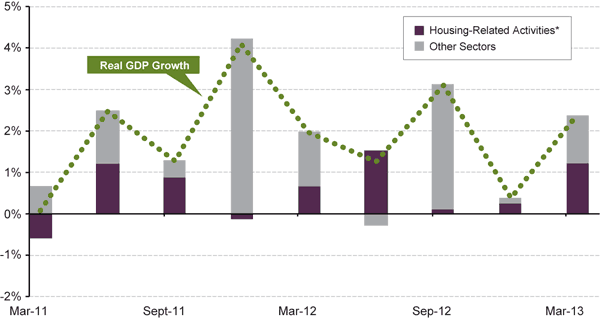The Trouble with Tapering
Rising interest rates are beginning to put pressure on the recovery in the housing market, which will affect economic output. This reduces the likelihood that the Fed will taper QE in 2013, and could even lead it to signal a possible expansion or extension of the current policies.
by Scott Minerd, CIO, Guggenheim Partners LLC
There is a greater-than-50 percent chance that the Federal Reserve will maintain the size and projected tenor of quantitative easing (QE) through the remainder of 2013. Policymakers have also indicated that the asset purchase program could be expanded if warranted by less-than-satisfactory economic performance.
Interest rates rose 59 basis points between May 1 and June 12 – equal to more than one third of the 10-year note’s yield at the start of that period. Mortgage applications fell sharply over the past month, in response, and a contraction in housing activity is likely if interest rates continue to rise. The Federal Reserve will do what is necessary to protect the contribution to GDP that is coming from new construction and the wealth effect from home price appreciation. A reduction in economic output due to a flattening in the vitally important housing sector will likely lead to lower interest rates. That could cause the signals coming out of the Fed to shift away from tapering, and possibly back toward increasing or extending QE.
Chart of the Week
Measuring the Impact of the Housing Recovery on GDP
The housing market recovery continues to provide substantial support to U.S. economic growth. Housing-related activities, defined as private residential investment, personal expenditures on household durable goods and utilities, and the wealth-effect on consumption from home price appreciation, have positively contributed to real GDP growth for five consecutive quarters. Housing-related activities contributed more than half of the real GDP growth in the first quarter of 2013.
CONTRIBUTION TO U.S. REAL GDP GROWTH FROM HOUSING-RELATED ACTIVITIES

Source: Haver Analytics, Guggenheim Investments’ estimates. Data as of 1Q2013. *Note: For simplicity, we don’t consider the impact of the housing boom on job creation, which could potentially add additional growth to the housing-related activities.
Economic Data Releases
Disappointing Production Data, but Positive Retail Sales
- Retail sales rose a better-than-expected 0.6% in May, with core retail sales up 0.3%.
- Industrial production was flat in May after falling in April. A large drop in utilities production offset gains elsewhere.
- The Empire manufacturing index improved in June to 7.84 after a negative reading in May, however, the components were weak.
- University of Michigan consumer confidence fell slightly from May’s six-year high to 82.7 in June.
- The NAHB housing market index jumped from 44 to 52 in June, the highest level since March 2006.
- Housing starts accelerated to an annualized pace of 914,000 in May, below forecasts but up 6.8% from April.
- Building permits dropped to a pace of 974,000 in May, still the second best pace in five years after April’s high.
- Initial jobless claims fell for a second straight week, down to 334,000 for the week ended June 8th.
- The CPI rose 1.4% year-over-year in May, after April’s 30-month low of 1.1%.
Eurozone Production and Prices Up
- Eurozone industrial production rose in April for a third straight month, up 0.4%.
- Consumer prices in the eurozone increased 0.1% in May, raising the year-over-year CPI to 1.4%.
- France’s May CPI inched up to 0.9% year-over-year after falling for eight months.
- The eurozone’s trade surplus decreased in April to €14.9 billion, as exports fell for the first time in four months.
- The ZEW survey showed a second consecutive increase in German economic sentiment in March, rising to 38.5.
- U.K. jobless claims fell 8,600, leaving the claimant count rate at a more than two-year low of 4.5%.
This article is distributed for informational purposes only and should not be considered as investing advice or a recommendation of any particular security, strategy or investment product. This article contains opinions of the author but not necessarily those of Guggenheim Partners or its subsidiaries. The author’s opinions are subject to change without notice. Forward looking statements, estimates, and certain information contained herein are based upon proprietary and non-proprietary research and other sources. Information contained herein has been obtained from sources believed to be reliable, but are not assured as to accuracy. No part of this article may be reproduced in any form, or referred to in any other publication, without express written permission of Guggenheim Partners, LLC. ©2013, Guggenheim Partners. Past performance is not indicative of future results. There is neither representation nor warranty as to the current accuracy of, nor liability for, decisions based on such information.











